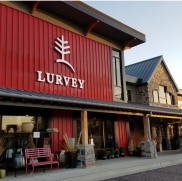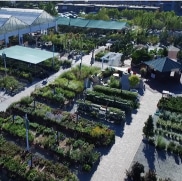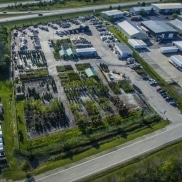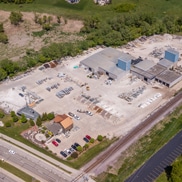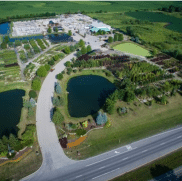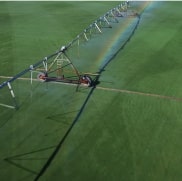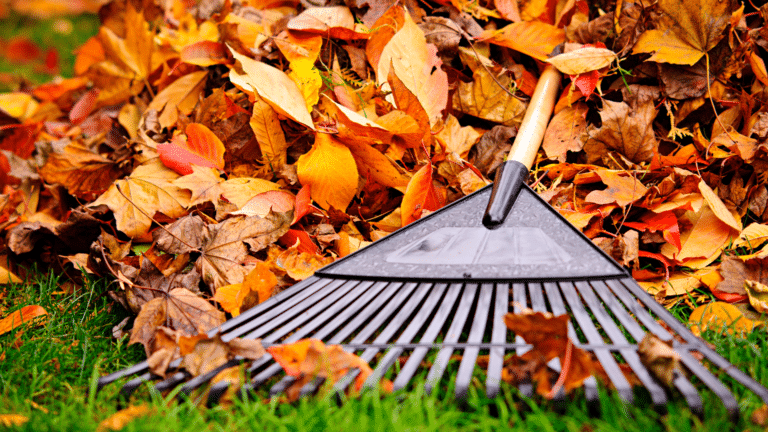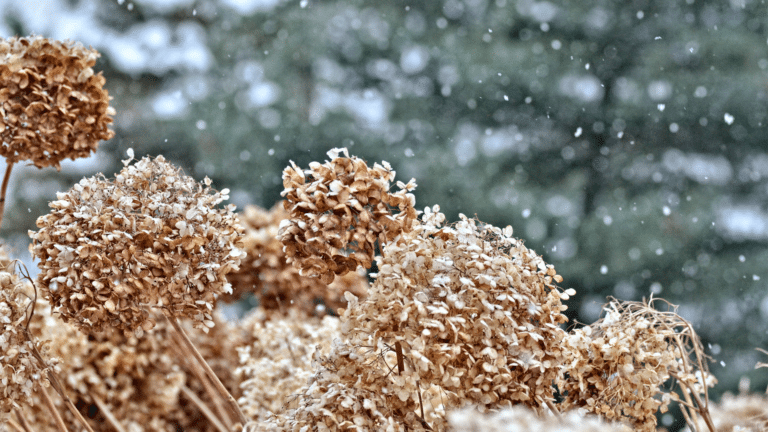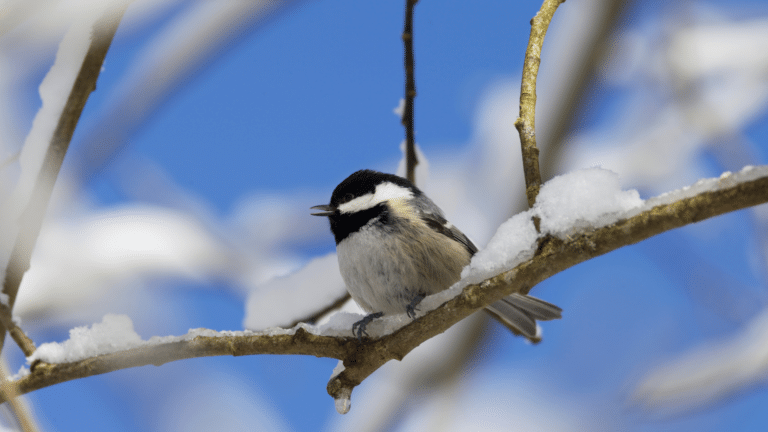GARDEN SITE SELECTION
The size of the garden should be determined by available space, your needs, and the amount of time and effort you’re willing to put into it. Proper site placement is important. Most vegetables and herbs require full sun, which is a minimum of 6 hours. Avoid areas that are close to trees because of shading and root issues. The garden bed should have good drainage and no pooling problems after heavy rains. Raised beds are a great solution for problem soils. Excessively windy areas should have a wind break such as a fence or landscape plantings. Garden beds also should be in easy access of water supply.
Don’t despair if you lack the area for a garden! Container gardens can be quite successful by using the right techniques. Additionally, some vegetables can grow in part sun/shade.
GARDEN LAYOUT
Review your site and do some planning! Decide what vegetables and herbs your household will use and enjoy, then draw a layout sketch of the garden. The labels on Lurvey’s vegetables and herbs have spacing and planting recommendations. Overcrowding your plants reduces production and encourages insect problems while proper spacing provides good air circulation helping to control pests and diseases. A good garden layout should allow enough room for easy cultivation. Save your garden drawings, photos, and notes for reference year after year.
GET TO KNOW YOUR SOIL
Gardening success starts with the soil. Healthy soil contains roughly 25% air, 25% water, 45% minerals and 5% organic matter. Healthy soil is alive – one teaspoon of compost rich soil can host 600 million to 1 billon healthy bacteria! A soil test will indicate your garden’s pH (if it’s acidic or alkaline soil) and what nutrients are present; new and existing gardens should be tested. Our home soil test kits are easy to use. Make sure to read all the instructions and information included in the kits. The test kits results will offer recommendations for adjusting soil pH and fertilizers for maximum plant performance. Generally, most vegetables and herbs enjoy a soil pH of 6.2 to 7.0. Acidic soils (low in pH) can be corrected by the addition of Espoma Garden Lime. Alkaline soils (high in pH) require Espoma Soil Acidifier.
A healthy garden must have the proper balance of nutrients. Nitrogen promotes leafy top growth while Phosphorous promotes root growth along with flower and fruit production. Potassium (Potash) improves general durability and promotes disease resistance and cold hardiness.
Soil tests let you know if there is too little or too much of a nutrient. Proper fertilizers and quantities can then be determined and applied correctly. Soil testing eliminates the guesswork and will save you money on unneeded amendments!
AMENDING YOUR SOIL NATURALLY
Your goal is good soil texture, drainage, and fertility. Excessive clay can cause major problems with veggies including slow growth and poor production A quick check for clay in your planting beds is to make a ball about 1” diameter with moist soil. Squeeze it between your thumb and forefinger. Then, watch the band of soil that pushes up and if the band stays intact after an inch or two it, the soil contains a fair amount of clay! Lurvey Home & Garden offers several great amendments for breaking up clay and adding nutrients.
Compost is the best way to improve any garden’s soil and is considered nature’s overall finest soil amendment. Rich in soil nutrients, compost improves soil structure, aeration and enhances positive soil bacteria. Evenly spread a 2-inch layer of compost across your garden and work it in. It’s good practice to do this yearly if possible. Soil amendments are best added in early spring, a month before planting or in the fall after garden clean-up. To clarify, materials to correct soil pH (lime for acid soil, sulfur for alkaline soil) are best added in the fall.
Mushroom compost and Cotton burr compost are also a good source of nutrients and organic matter. Fully composted manure releases nutrients slowly into the soil and builds soil structure. Espoma Organic Tones have the essential nutrients your soil needs to grow specific hearty, healthy plants. Lurvey carries many varieties of granular organic fertilizer amendments. Also available are many soil mixes for raised beds and amendments such as peat moss and garden soils. A word of caution: avoid fresh manure which can burn plant roots and can contain unwanted weed seeds.
Note: Do not work in your garden if the soil is wet! You can cause soil compaction, closing air pores necessary for healthy soil micro-organisms. If you are using a rototiller, easy does it. Do not over pulverize the soil! The powdered soil might look nice, but you’ll damage its structure and collapse air pores necessary for plants roots, proper drainage, and the health beneficial soil organisms.
WHEN TO PLANT
Watch the temperatures before planting! Outside temperatures are obviously important so avoid planting when a frost is predicted. Soil temperatures are the key to when you should plant, 50 degrees soil and minimum 55-degree air temperature for seedlings and plants to grow. A soil thermometer is an invaluable gardening tool. Seed packets are marked with safe planting temperatures for certain veggies.
Try to plant on an overcast day with moderate rain predicted. Always be prepared to cover transplants and seedlings if or when the temperatures take a plunge.
Here’s a link to a great web site for additional information from the University of Illinois Extension: http://urbanext.illinois.edu/veggies/planting.cfm
FERTILIZERS
Consider the type of fertilizer you are going to use. Organic fertilizers feed slowly, supplying all your plants’ needs as well as improving the soil. These fertilizers work best when the soil temperatures rise above 50˚. Organic fertilizers are less likely to burn plants if too much is used, and they contribute to soil structure. Chemical fertilizers work fast and are less expensive, however, overuse of chemical fertilizers can cause your soil to gradually lose organic content and micro activity.
Good organic fertilizers
Are balanced and contain trace elements, beneficial microbes, and mycorrhizae. The microbes convert the nutrients at a steady rate to a form that plants can use. Roots are then able to get extra nutrition from the soil. These types of fertilizer should be worked into the soil near the plant’s root zone at planting time. Additional fertilizer should be applied during the growing season to meet the crop’s seasonal needs. We recommend Espoma fertilizers.
Water soluble fertilizers
Work well and are convenient. Foliar feeding with a water-soluble fertilizer is a great way to get nutrients and minerals directly into the plant through the leaves. For this reason, foliar fertilizing may be necessary in cold soil conditions. Thousands of microscopic pores are located mainly on the underside of the leaf. Spray the entire plant, especially the undersides of the leaves with a liquid fertilizer solution. The finer the spray you use, the better. Foliar feeding works best early in the morning of a cool, overcast day. Make sure the plants are well watered the day before a foliar spray. Moreover, do not spray at temperatures of 80˚ or warmer as this may burn foliage. Properly timed applications will help a plant through its seasonal needs. Foliar feeding is economical and highly effective.
Read, understand, and follow the instructions on the fertilizer you select. Follow the application rates and all precautions carefully. If you have any questions or need some extra information? Lurvey’s professional staff is here to help!
GARDEN WATERING CONSIDERATIONS
- Water your garden the day before planting.
- Thoroughly water your transplants for a couple hours before planting.
- Water deeply after planting.
- Keep seeded areas evenly moist daily.
- Water in the morning when possible. Evening watering encourages plant diseases.
- Don’t put your plants to sleep with wet feet.
- Your garden needs a minimum of 1- 3 inches of water per week.
- Chlorine has a negative effect on plants and positive bacteria in the soil. Use de-chlorinated water whenever possible. Fill up a watering can and a 5-gallon bucket and let it sit for a couple of days. The chlorine will dissipate, and the water temperatures will match the outside air (no cold shock to the plant).
- Consider a rain barrel to conserve on water and watering bills! Rainwater has a neutral PH and is free of minerals and chemical treatments which can negatively affect plants.
- Water the area around the plant’s base and not the foliage.
- Timers are a good option for working gardeners.
- Drip watering is a great way to conserve water and puts it where it is easily used near the root zone.
Lurvey Home & Garden always has your gardening success in mind! Our Garden Center offers healthy vegetable and herb plants, a great assortment of garden seed as well as fresh, asparagus roots, seed potatoes and onion sets. Our selection of quality soils, fertilizers, amendments along with our expert advice will help you produce a bountiful garden. After all, fresh vegetables and herbs abounding in vitamins, minerals and antioxidants are part of the rewards of your garden! You will have the satisfaction of knowing how and where your produce was grown.
